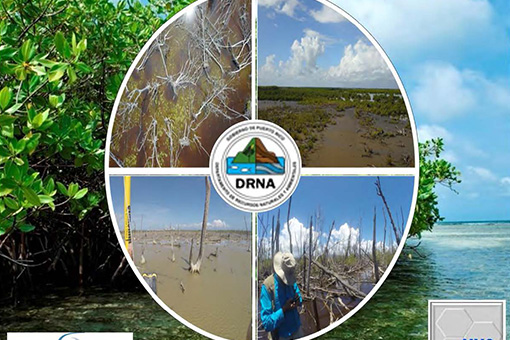Natural Infrastructure Restoration to Enhance Climate Resilience in Puerto Rico
Organization: The Ocean Foundation
Location: Salinas, Aguirre, Guayama, Puerto Rico, United States
Country: United States
Other Organizations Involved: Puerto Rico Department of Natural and Environmental Resources (DNER); Jobos Bay National Estuarine Research Reserve (JBNERR); National Oceanic and Atmospheric Administration (NOAA); Conservación ConCiencia; Jetblue Airways

Background
The Jobos Bay National Estuarine Research Reserve (JBNERR) is a federally protected estuary located in the municipalities of Salinas and Guayama in the southern part of Puerto Rico. The 2817-acre reserve contains five distinct habitat types and provides sanctuary to endangered species, including the brown pelican, peregrine falcon, hawksbill sea turtle, green sea turtle, several species of shark, and the West Indian manatee. Through human intervention and targeted restoration activities, the rate of recovery in damaged mangrove forests can be dramatically increased thereby minimizing wider impacts to the environment and surrounding communities. The proposed pilot mangrove restoration project capitalizes on threat and vulnerability assessments and local coastal planning that has been performed to date.
Goals
The pilot mangrove restoration project, the primary objective of this proposal, will be completed during the period of performance since it has already undergone the planning and permitting process. A secondary objective of this project proposal is to lay the groundwork to significantly expand the current pilot mangrove restoration project by better understanding and addressing persistent hydrological issues on the eastern part of the Reserve through additional planning, stakeholder engagement, partner training, site characterization, and expanded permitting.
Main activities
- Collect mangrove stock (seeds, propagules, and saplings). Establish mangrove seedling / propagule holding area. Transport mangrove propagules, seedlings, and saplings to site. Conduct topographic restoration and mangrove shoreline root mat stabilization. Plant mangrove propagules.
- Conduct detailed investigations of the community ecology and structure of the naturally occurring mangrove species at the expanded project site, in particular the patterns of reproduction, distribution, and successful seedling establishment. Perform comprehensive assessment of the modifications of the mangrove environment that occurred as a result of past hydrological modification and that currently prevent natural secondary succession. Develop an expanded mangrove restoration plan for the eastern part of Jobos Bay. Submit an updated joint permit to the Army Corps of Engineers to include new expanded sites.
Results
A significantly expanded mangrove restoration plan (100-200 acres) will be developed for the eastern part of Jobos Bay that will provide greater protection for vulnerable coastal communities and critical power-generating infrastructure. Local partners will participate in all stages of site assessment, field activities, hydrological modeling, restoration planning, and permitting.